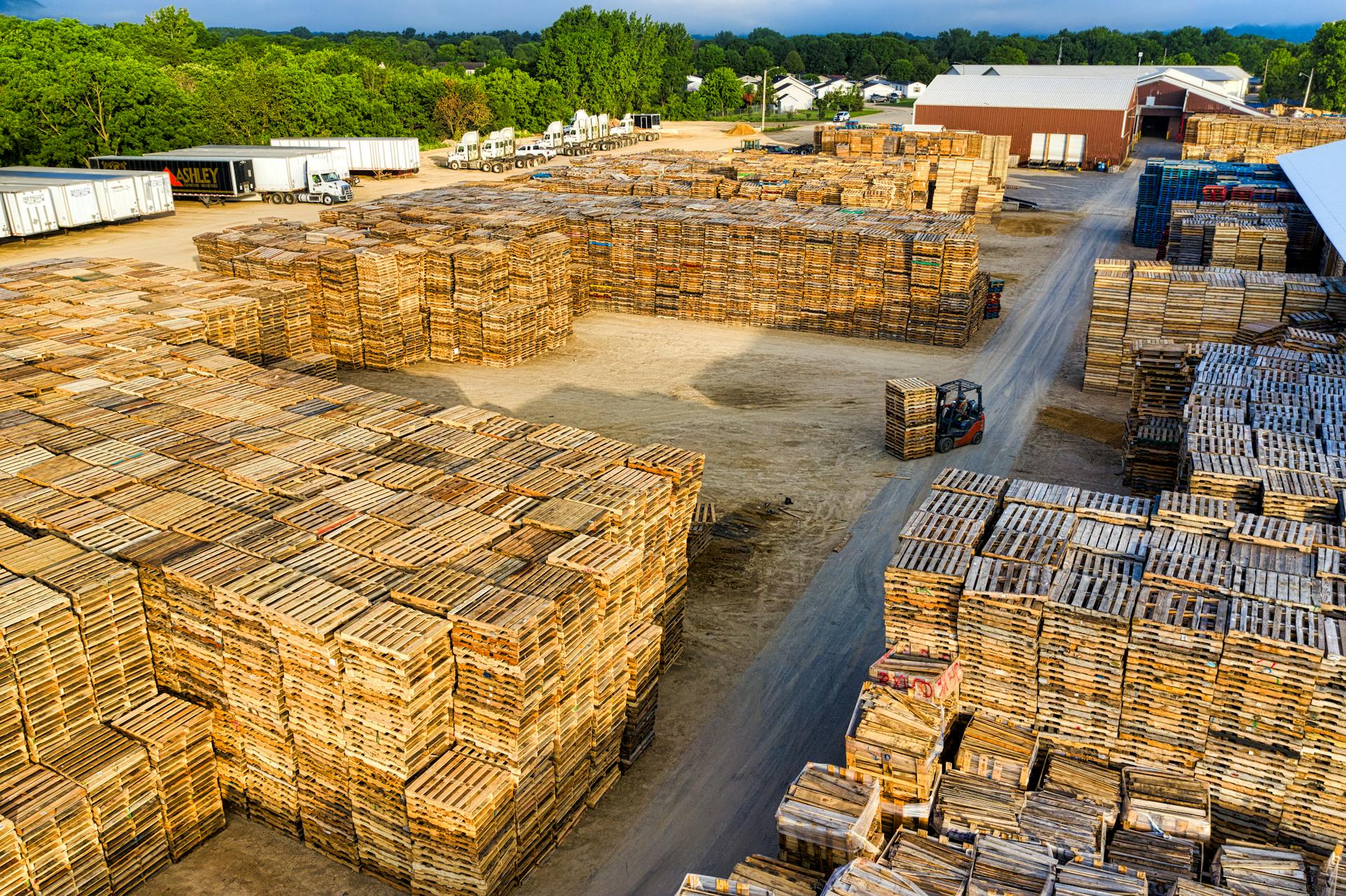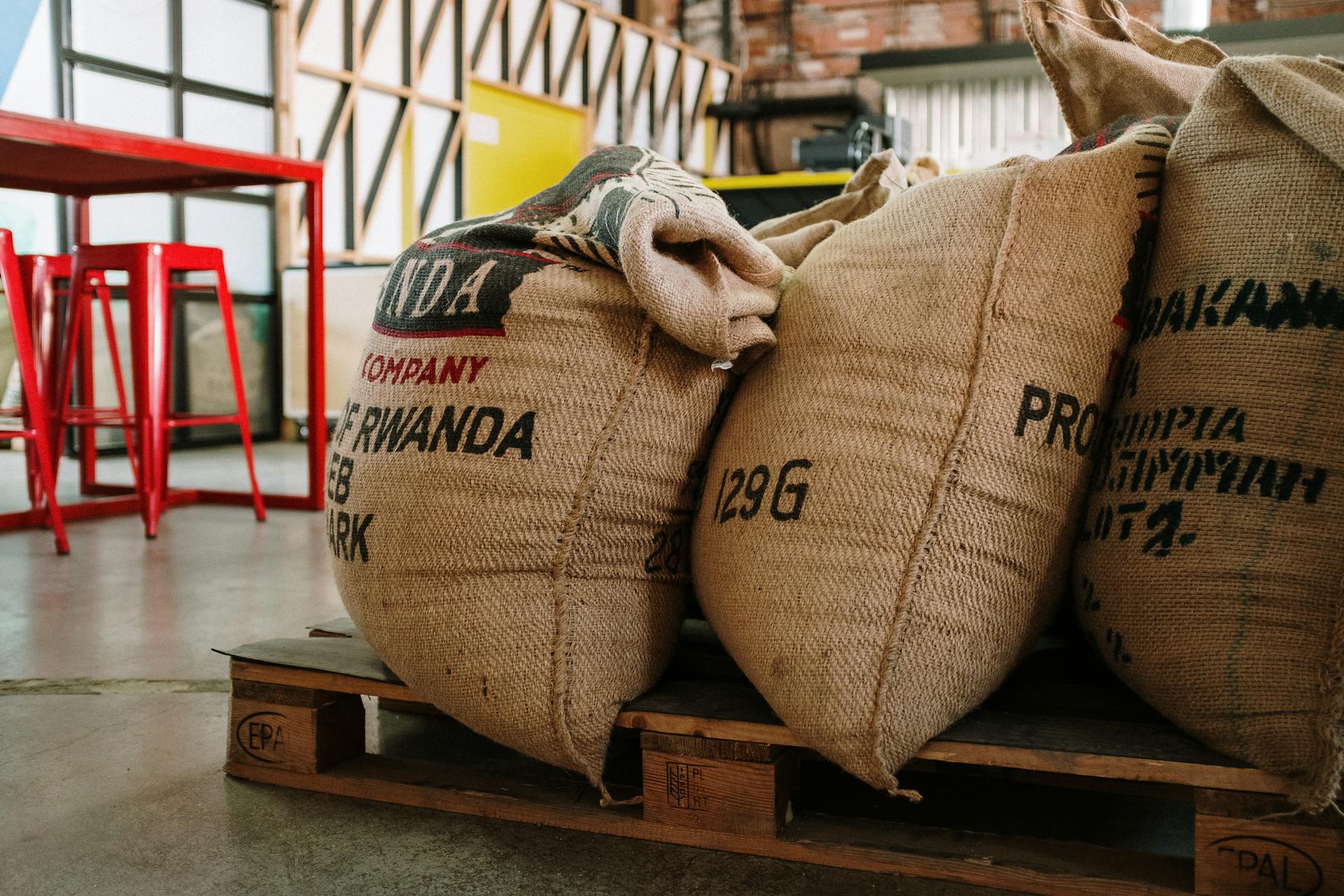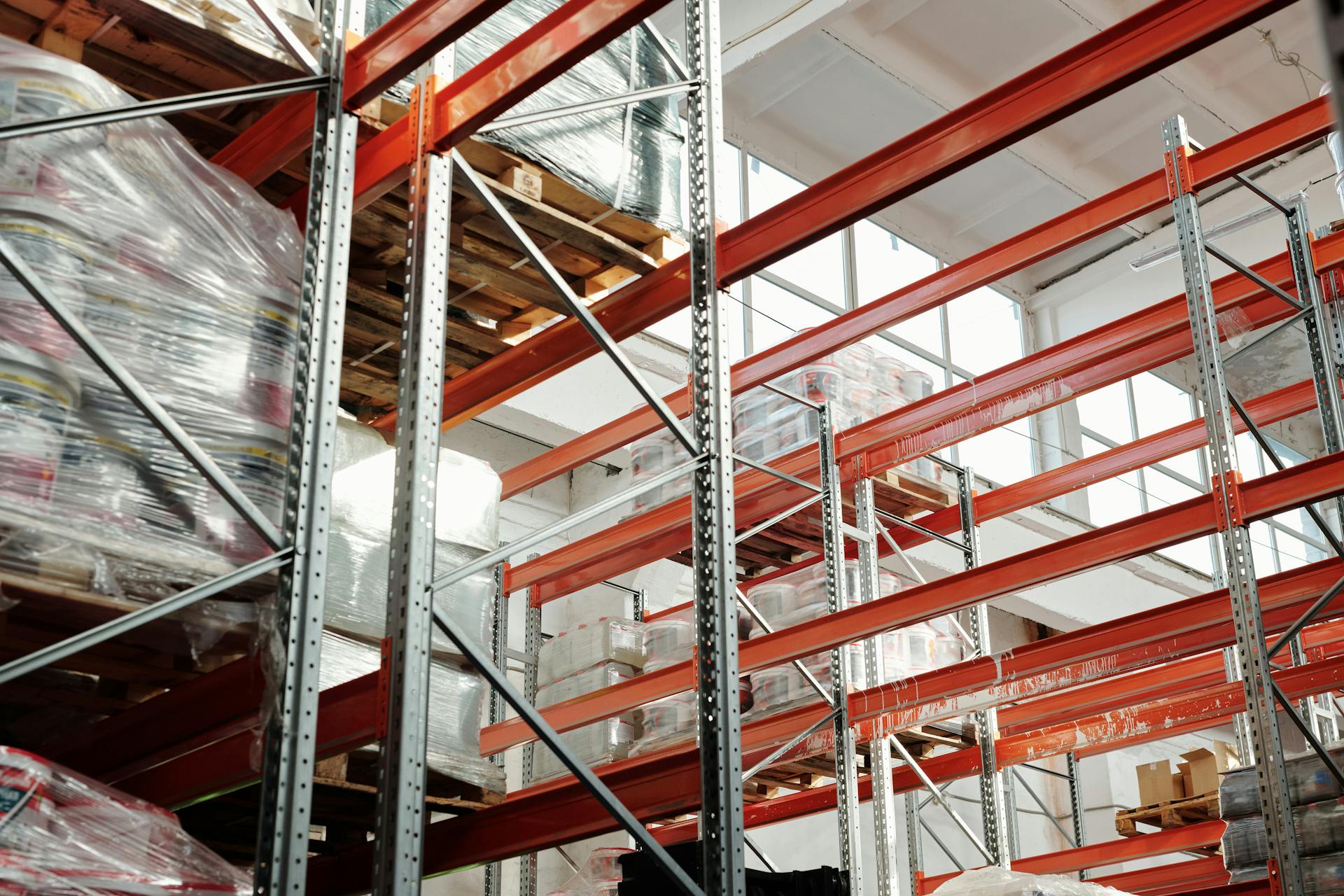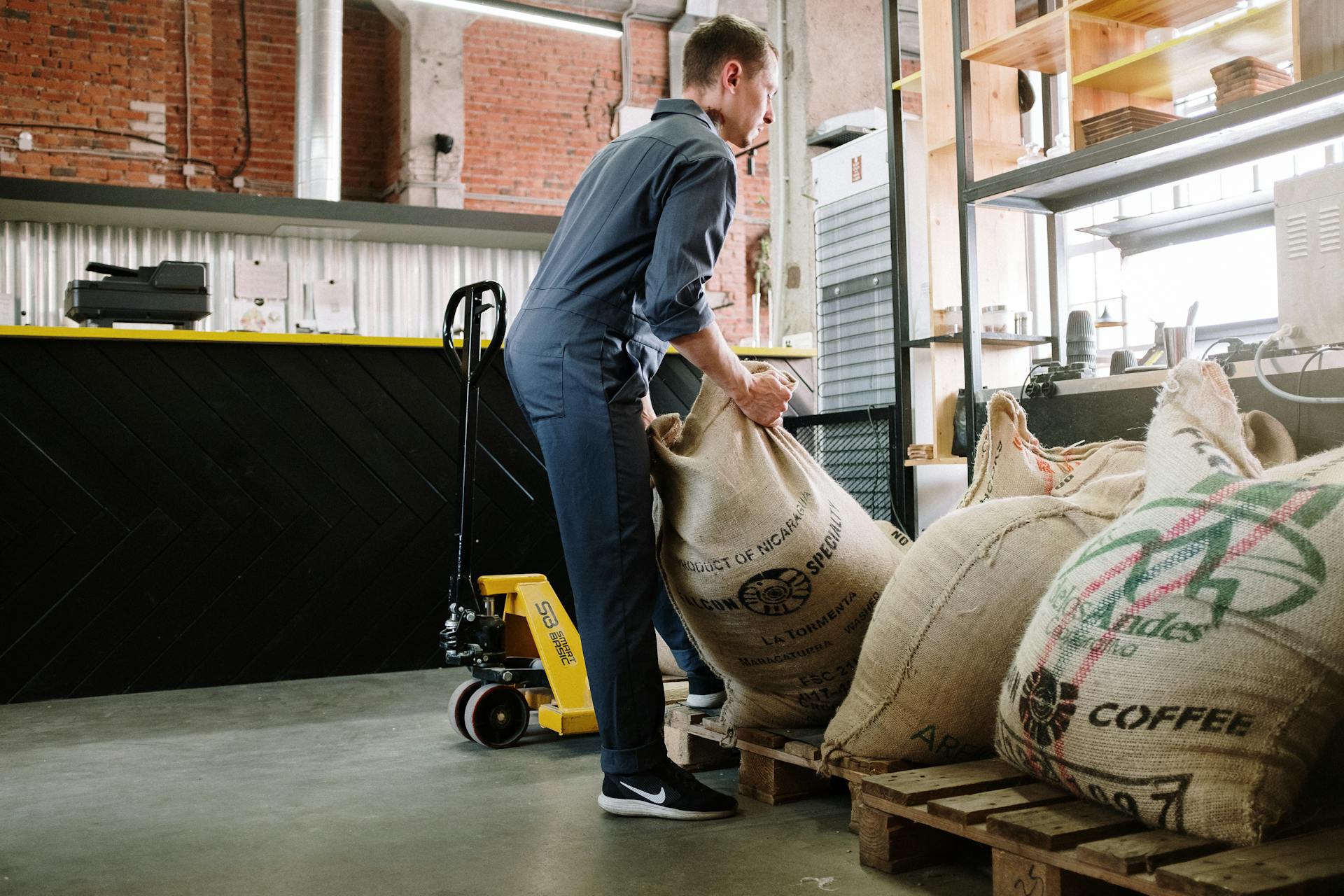
Stringer pallets are a type of pallet that uses a stringer design, which consists of two longitudinal boards attached to the top and bottom decks. This design provides excellent support and stability to the pallet.
Stringer pallets are commonly used in the shipping and logistics industry due to their durability and ability to withstand heavy loads. They are also relatively easy to manufacture and maintain.
The choice of stringer pallet depends on the specific needs of the user, including the type of goods being transported and the frequency of use. Stringer pallets come in a range of sizes, from standard to custom sizes, to accommodate different applications.
Design and Features
Stringer pallets have a top and bottom deck that provides support for the load. This design feature makes them suitable for multiple loads or trips.
The stringers that run between the decks are made of sturdy wood, allowing the pallet to withstand heavy loads. Notches in the stringer pallet grant access to the pallet in all directions, making it easy to transport goods with a forklift.
A forklift can easily enter the pallet from a 2 or 4-way, making it convenient for loading and unloading goods.
What Makes Pallets Different

Pallets are designed with specific features that set them apart from other types of packaging. They are typically made of wood, plastic, or metal, and are often used in industrial settings.
Their standard size is 40 inches by 48 inches, making them easy to stack and transport. This size also allows for efficient use of space in warehouses and storage facilities.
The weight capacity of pallets can vary depending on their material and design, but most can support loads of up to 4,000 pounds. This is crucial for ensuring the safe transportation of heavy goods.
Pallets often have a grid pattern of wooden boards, which provides additional support and helps to distribute the weight evenly. This design also makes it easy to secure goods in place with straps or bands.
Their open-top design allows for easy loading and unloading of goods, making them a convenient option for businesses that need to transport a wide range of products.
Explore further: Electric Pallet Truck Weight
Design and Access

Stringer pallets have stringer boards running along them to support a load, making them suitable for lighter loads and two-way access.
Their design allows for easy handling with a forklift, which can enter the pallet in a 2-way direction.
Stringer pallets can be upgraded to four-way access with additional notches, increasing their versatility.
Block pallets, on the other hand, have boards placed in the corners and at the center of the pallet, making them four-way pallets by default.
This design allows block pallets to be accessed from any direction, making them ideal for heavier loads and rough handling.
Their four-way entry design makes them a reliable choice for more demanding environments.
Block pallets are a better option for businesses that deal with heavier loads or need pallets that can withstand rough handling.
Stringer pallets offer good performance at a lower price point, making them a cost-effective choice for businesses with lighter loads.
Suggestion: Material Handling Conveyor Systems
What's on the Pallet?
The pallet's design is built around a sturdy frame, which starts with the top and bottom decks that run width-wise. These decks are the foundation of the pallet.
The stringers, also known as runners, are boards sandwiched between the decks and run perpendicular to them. Madison County Wood Products manufactures these stringers to be 2 x 4'.
The overall structure of the pallet is reinforced by the runners, which provide stability and support.
Defining Characteristics of a Pallet
Stringer pallets are defined by the presence of long pieces of wood called stringers that run along their length, supporting the deck boards and providing the necessary structure and strength.
These stringers are typically notched to allow forklifts to lift the pallet from all four sides, making them a convenient choice for businesses that rely on heavy machinery.
Stringer pallets are generally cheaper to produce than block pallets, which is one of the key benefits of this design.
Customization is also a major advantage of stringer pallets, as they can be easily modified to meet the specific needs of a business.
The stringers on a pallet are often made of 2 x 4' boards, which provide the necessary reinforcement to the structure of the pallet.
The runners, also known as stringers, run perpendicular to the top and bottom decks, adding to the overall strength and stability of the pallet.
Pallet Types and Selection
When it comes to choosing the right pallet for your business, you have two main options: stringer pallets and block pallets. The choice between them depends on several factors, including your budget, the nature of your goods, and your handling requirements.

Stringer pallets are generally cheaper to produce than block pallets, making them a cost-effective option for businesses with relatively light loads. They're also easy to customize, which is ideal for businesses that need custom wood pallets.
The design of stringer pallets, with stringer boards running along them to support a load, impacts how they can be used in a warehouse environment. They're typically two-way or partial four-way pallets, which means they can only be accessed from two directions unless they have additional notches.
Types of Existence
Pallets come in a variety of materials, including wood, plastic, cardboard, and metal.
Each type of pallet has its own benefits and pitfalls, making them worth considering.
Pallets can be made from wood, plastic, cardboard, or metal, offering different options for transporting goods.
Stringer pallets and block pallets made of wood are the most common types used in the United States.
Here are the main types of pallet materials:
- Wood
- Plastic
- Cardboard
- Metal
Weight Capacity
When selecting a pallet, it's crucial to consider the weight capacity of your products. Ensure that the chosen pallet design can safely support the weight of your products.
Heavier items often require custom pallet designs. For example, pallets used to transport heavy machinery might need extra reinforcement to prevent damage or collapse.
A standard pallet typically has a weight capacity of around 2,000 to 4,000 pounds. However, this can vary depending on the specific design and materials used.
Custom pallets can be designed to handle even heavier loads, making them ideal for industries that require transporting large or heavy products.
Broaden your view: Heavy Duty Pallet Trucks
Storage Conditions
Storage conditions can be a challenge, especially if you're shipping products to consumers.
The distance traveled and transfer frequency of your pallets can greatly impact their exposure to stress and strain. This can lead to damage or even safety issues.
You should consider whether your pallets will be exposed to consumers, as this can affect the handling and storage conditions they endure.
The right pallet design can make a significant difference in handling and storage conditions.
Consider reading: Pallets for Storage
Selecting the Ideal Pallet Type
Selecting the ideal pallet type for your application depends on several crucial factors that align with your specific shipping and storage requirements.
The choice between block pallets and stringer pallets depends on several factors. Key considerations to keep in mind include budget, the nature of your goods, and handling requirements.
Stringer pallets are a popular choice for many businesses due to their cost-effectiveness. They're generally cheaper to produce than block pallets.
Stringer pallets have notches cut into the stringers, allowing forklifts to lift them from all four sides. This feature makes them ideal for businesses needing custom wood pallets.
The weight capacity of the chosen pallet design is crucial to ensure it can safely support the weight of your products. For heavier items, custom pallet designs may be necessary.
Different products have distinct shipping and storage needs, including size, weight, and fragility. Some industries may require specific pallet sizes, materials, or treatments to meet regulatory requirements.
The most common types of pallets used for transporting goods in the United States are stringer pallets and block pallets made of wood.
If this caught your attention, see: Lift Gate Weight Limit
Block: Two Main Designs

Block pallets are the most common design, known for their durability and ease of handling.
Block pallets are made with solid wood blocks, which provide stability and support for heavy loads.
They are ideal for businesses that need to transport large or heavy items, as they can withstand rough handling and harsh environments.
Block pallets are also cost-effective, making them a popular choice for companies on a budget.
Their solid wood construction makes them resistant to damage and wear and tear, reducing the need for frequent replacements.
By choosing block pallets, businesses can save money in the long run and minimize their environmental impact.
A different take: Heavy Duty Electric Pallet Jack
Pallet Blocks and Accessories
The stringer pallet is designed to support multiple loads or trips, making it a reliable choice for transporting goods. With sturdy stringers running between the decks, this pallet can handle heavy loads with ease.
Notches in the stringer pallet allow forklift access in all directions, making it easy to transport goods from point A to point B. This feature is especially useful when working in tight spaces.

Bryan Kesting, VP of Sales for Madison County Wood Products, is proud to serve the company's clients and team members, from loggers to drivers delivering finished goods. He's committed to helping the company achieve its goal of being an incredibly vertically operated wood products company.
The stringer pallet's design enables forklifts to enter the pallet in a 2 or 4-way, providing flexibility in transportation options. This feature can be a game-changer for businesses looking to streamline their logistics.
Benefits
Stringer pallets offer a great value for their specifications and properties.
Standardized sizes for stringer pallets can vary, but 48' x 40' is a common size for many industries.
Custom sizes can be created to meet specific needs, such as 44' x 44' or 48' x 48', as seen with Madison County Wood Products.
Stringer pallets can be stacked on top of each other, making them a space-efficient option.
This ability to stack pallets is a key benefit of using stringer pallets in your operations.
Choosing the Right Pallet for Your Business
Choosing the right pallet for your business can be a daunting task, but it's essential to get it right. You need to consider the weight capacity of the pallet, as some can support more weight than others.
The size of the pallet is also crucial, as it will determine how many products you can fit on each one. If you have large products, you'll need a bigger pallet.
Storage conditions are another important factor to consider. If you're storing materials that need to be kept dry, you'll want to choose a pallet made from a material that can withstand moisture.
You should also consider the provider of the pallets. Not all pallet suppliers are created equal, and some may offer better quality or prices than others.
Here are some key factors to consider when choosing a pallet:
- Weight Capacity: How large of a load do you expect each pallet to support?
- Size: How many products do you want to have on each pallet?
- Storage Conditions: How will you be storing your products and pallets?
- Provider: What kind of quality and price can you expect from the supplier?
Frequently Asked Questions
What is a stringer on a pallet?
A stringer on a pallet is a horizontal board that supports the top and bottom deckboards, typically made from 2 x 4's or 3 x 4's. This structural component is a key feature of stringer pallets, which are widely used in the United States.
What is stringer length pallet?
A stringer length pallet is a type of pallet with a standard length of 48 inches, commonly used in the United States for consumer products.
What is the difference between a wood stringer pallet and a wood block pallet?
Wood stringer pallets and wood block pallets differ in their load support systems, with stringer pallets featuring horizontal boards and block pallets using corner and center boards
How much weight can a stringer pallet hold?
A stringer pallet can hold a maximum of 2,500 pounds, with dynamic loads ranging from 2,200 to 2,500 pounds. Learn more about the safe loading capacities of stringer pallets to ensure secure shipping and storage.
Sources
- https://challengerpallet.com/blog/posts/the-primary-distinctions-between-stringer-and-block-pallets/
- https://www.albamfg.com/blog/understanding-the-differences-between-stringer-pallets-and-block-pallets-making-the-right-choice-for-your-supply-chain/
- https://www.mcwp.com/post/stringer-pallets-explained
- https://igps.net/block-pallet-vs-stringer-pallet-choosing-a-platform/
- https://www.falm.com/2024/07/stringer-vs-block-pallets-whats-the-difference/
Featured Images: pexels.com

